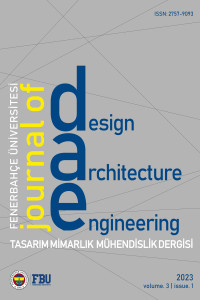Hizmet Binası Tasarımında Kurumsal Kimlik ve Mekansal Kurgu: Kars Tapu ve Kadastro Müdürlüğü Hizmet Binası Örneği
Öz
Kamusal alanlar, halkın erişimine açık, halkın istek ve ihtiyaçlarına göre şekillenen, bir kurum tarafından kontrol edilen ve yönetilen ortak ve erişilebilir alanlardır. Devlet erki ve hizmet binaları eksenindeki kamusal sorumluluk, kullanıcıların kolektif hafızalarında yer edinerek toplumsal sürdürülebilirliği sağlamaktadır. Kurumsal kimlik ve kurumsal ihtiyaçlar bu yapılarda mimariyi şekillendirmektedir. Tapu ve Kadastro Müdürlüğü Hizmet Binaları, tapu ve kadastro arşivlerindeki mülkiyet bilgilerinin saklandığı, halka hizmet veren ve ofis alanlarını içeren, kamuya açık, erişilebilir binalar olmalıdır. Bu çalışmanın kapsamı Kars Tapu ve Kadastro Müdürlüğü Hizmet Binası'nın tasarım ve planlama sürecinin kurumsal kimlik ve mekansal organizasyon ile birlikte anlatılmasıdır. Çalışma, mimari tasarım sürecine odaklanmaktadır. Bu süreci, tasarımı biçimlendiren ve işlevselliği sağlayan gereklilikler ile beraber ele alan bu çalışmanın amacı, benzer nitelikteki kamu hizmet binaları için temel nitelik ve ihtiyaçların tespit edilmesi, aynı zamanda yapı tasarım süreci deneyiminin paylaşılmasıdır. Çalışmanın, benzer yapılar için ihtiyaç programı oluşturulmasında yardımcı olması, mekan kurgusu ve organizasyonu konularında kaynaklık etmesi öngörülen kazançlarıdır.
Anahtar Kelimeler
Mimari Tasarım Mekânsal Organizasyon Mimari Proje Süreci Kamu Yapıları Kurumsal Kimlik
Kaynakça
- Dursun, P. (2012). Dialogue on Space: Spacial Codes and Language of Space, İTÜ Mimarlık Fakültesi Dergisi, 9(1), 104-119.
- Habermas, J. (2004). “Kamusal Alan”. Kamusal Alan (iç.). (M. Özbek, Der. ve Çev.). İstanbul: Hil Yayın.
- Hillier, B. & Hanson, J. (1997). The Reasoning Art: or the Need for an Analytical Theory of Architecture, Proceedings of the 1st Space Syntax International Symposium, London.
- Gedenryd, H., (1998). How Designers Work: Making Sense of Authentic Cognitive Activities, Jabe Offset AB, Lund, İsveç.
- General Directorate of Land Registry and Cadastre. (2022). Access Address (14.06.2022): https://www.tkgm.gov.tr/tarihce-ve-gorevler
- Government Buildings Operation, Maintenance, Repair Regulation. (1971) T.C. Resmi Gazete (Sayı: 13999). Başbakanlık Basımevi, Ankara. Access Address (20.06.2022): https://www.mevzuat.gov.tr/MevzuatMetin/3.5.73228.pdf
- Karadayı Yenice, T. (2019). Hasan Kalyoncu Üniversitesi Konukevi Mimari Tasarımı. Artium, 7 (1), 50-56.
- Karadayı Yenice, T. (2019). Hasan Kalyoncu Üniversitesi Öğrenci Yurdu Mimari Proje Tasarım Süreci. Mimarlık Bilimleri ve Uygulamaları Dergisi, 4(2), 183-192.
- Lawson, B. (2005). Problems, solutions and The Design Process. How Designers Think, Architectural Press, Great Britain, 32, 121-125.
- Lefebvre, H. (2014). Mekânın Üretimi. (I. Ergüden, Çev.) İstanbul: Sel Yayıncılık.
- Okay, A. (2018). Kurum kimliği. İstanbul: Derin Yayınları, 23.
- Yürekli, İ., Yürekli, H. (2004). Mimari tasarım eğitiminde enformellik, İTÜ Dergisi/a, 3 (1): 53-62.
- Uzoğlu, S. (2001). Kurumsal kimlik, kurumsal kültür ve kurumsal imaj. Kurgu Dergisi, 18, 317-353.
Corporate Identity and Spatial Fiction in Service Building Design: Kars Land Registry and Cadastre Directorate Service Building Sample
Öz
Public spaces, which are accessible spaces that are formed according to the needs and wishes of the people, managed and controlled by a government agency, are the common space. Public responsibility in the axis of service buildings, which takes place in the collective memories of the users, ensures social sustainability. Corporate identity and institutional needs shape the architecture in these buildings. Land Registry and Cadastre Directorate Service Buildings should be public, accessible buildings that contain office areas and serve the public, where property information in the land registry and cadastre archives is stored. The scope of this study is to describe the design and planning process of the Kars Land Registry and Cadastre Office Building together with its corporate identity and spatial organization. The study focuses on the architectural design process. The aim of this study, which deals with this process together with the requirements that shape the design and provide functionality, is to determine the basic qualities and needs for similar public service buildings, and to share the experience of the building design process. It is expected that the study will help in the creation of a needs program, and will be a source for space setup and organization.
Anahtar Kelimeler
Architectural Design Spatial Organization Architectural Project Process Public Buildings Corporate Identity
Kaynakça
- Dursun, P. (2012). Dialogue on Space: Spacial Codes and Language of Space, İTÜ Mimarlık Fakültesi Dergisi, 9(1), 104-119.
- Habermas, J. (2004). “Kamusal Alan”. Kamusal Alan (iç.). (M. Özbek, Der. ve Çev.). İstanbul: Hil Yayın.
- Hillier, B. & Hanson, J. (1997). The Reasoning Art: or the Need for an Analytical Theory of Architecture, Proceedings of the 1st Space Syntax International Symposium, London.
- Gedenryd, H., (1998). How Designers Work: Making Sense of Authentic Cognitive Activities, Jabe Offset AB, Lund, İsveç.
- General Directorate of Land Registry and Cadastre. (2022). Access Address (14.06.2022): https://www.tkgm.gov.tr/tarihce-ve-gorevler
- Government Buildings Operation, Maintenance, Repair Regulation. (1971) T.C. Resmi Gazete (Sayı: 13999). Başbakanlık Basımevi, Ankara. Access Address (20.06.2022): https://www.mevzuat.gov.tr/MevzuatMetin/3.5.73228.pdf
- Karadayı Yenice, T. (2019). Hasan Kalyoncu Üniversitesi Konukevi Mimari Tasarımı. Artium, 7 (1), 50-56.
- Karadayı Yenice, T. (2019). Hasan Kalyoncu Üniversitesi Öğrenci Yurdu Mimari Proje Tasarım Süreci. Mimarlık Bilimleri ve Uygulamaları Dergisi, 4(2), 183-192.
- Lawson, B. (2005). Problems, solutions and The Design Process. How Designers Think, Architectural Press, Great Britain, 32, 121-125.
- Lefebvre, H. (2014). Mekânın Üretimi. (I. Ergüden, Çev.) İstanbul: Sel Yayıncılık.
- Okay, A. (2018). Kurum kimliği. İstanbul: Derin Yayınları, 23.
- Yürekli, İ., Yürekli, H. (2004). Mimari tasarım eğitiminde enformellik, İTÜ Dergisi/a, 3 (1): 53-62.
- Uzoğlu, S. (2001). Kurumsal kimlik, kurumsal kültür ve kurumsal imaj. Kurgu Dergisi, 18, 317-353.
Ayrıntılar
| Birincil Dil | İngilizce |
|---|---|
| Konular | Mimarlık |
| Bölüm | Araştırma Makaleleri |
| Yazarlar | |
| Yayımlanma Tarihi | 21 Haziran 2023 |
| Gönderilme Tarihi | 24 Temmuz 2022 |
| Yayımlandığı Sayı | Yıl 2023 Cilt: 3 Sayı: 1 |


